How a Pentecostal preacher in Kenya persuaded hundreds of worshipers to starve themselves — and their children — to death.
Read: The Dial [The Pundits Issue]
How a Pentecostal preacher in Kenya persuaded hundreds of worshipers to starve themselves — and their children — to death.
Read: The Dial [The Pundits Issue]
German authorities looked the other way as a right-wing terrorist cell went on a seven-year killing spree. Now they won’t look in the mirror.
Read: Foreign Policy Magazine
As featured on Longform
What It’s Like to Be a Refugee in Germany’s Conservative Stronghold
 One afternoon, in a plaza in the center of Dresden, a tall man with a fatherly face and glasses insists that our interview be videotaped. Tourists and natives sit on patios eating sandwiches and ice cream as the man’s colleague tries to get the video camera working. An old man in a straw hat approaches me to admire my interview subject. “Just so you know—in anti-Islamic dialogue, he is the No. 1 in Germany! That’s why they call him a Nazi. And he is definitely not a Nazi.”
One afternoon, in a plaza in the center of Dresden, a tall man with a fatherly face and glasses insists that our interview be videotaped. Tourists and natives sit on patios eating sandwiches and ice cream as the man’s colleague tries to get the video camera working. An old man in a straw hat approaches me to admire my interview subject. “Just so you know—in anti-Islamic dialogue, he is the No. 1 in Germany! That’s why they call him a Nazi. And he is definitely not a Nazi.”
With the camera finally ready, the man begins his speech, gesticulating as though to a live television audience, even though only a couple curious onlookers are watching. He warns of a surge of radical Islam in Germany. It’s the result, he says, of the masses of Muslim refugees—men in particular—who have arrived here in recent years on the pretense of seeking asylum.
“Islam is used as a legitimization of rape and the willingness to achieve power through terrorism,” he tells me in German through an interpreter. “They have a totally different culture and a totally different attitude toward women and violence.”
The man’s name is Michael Stürzenberger, and he’s one of the better-known figures in a movement called Patriotic Europeans Against the Islamization of the West, or PEGIDA. PEGIDA rose primarily in opposition to Germany’s open-door refugee policy. In a calm, matter-of-fact tone, Stürzenberger tells his imaginary audience that the Muslims want to build 100 mosques in Munich. “They want to eliminate Judaism and Christianity,” he says. “They are friendly to the outside. But that is all part of their agenda.”
 Within an hour, Stürzenberger’s audience is no longer make-believe: He’s on a stage in the center of the plaza, speaking before a crowd of some 2,500 PEGIDA enthusiasts. They’ve assembled to air their grievances against Islam, liberalism, and the media. They use terms like Lügenpresse (“lying press”), a rallying cry used by the Nazis that recently found its way from Germany to America, in the form of social media posts from certain Donald Trump supporters. “There is a TV crew here from Texas called Infowars,” Stürzenberger tells the crowd. “They are the good ones—they are for Trump. Be nice to them.”
Within an hour, Stürzenberger’s audience is no longer make-believe: He’s on a stage in the center of the plaza, speaking before a crowd of some 2,500 PEGIDA enthusiasts. They’ve assembled to air their grievances against Islam, liberalism, and the media. They use terms like Lügenpresse (“lying press”), a rallying cry used by the Nazis that recently found its way from Germany to America, in the form of social media posts from certain Donald Trump supporters. “There is a TV crew here from Texas called Infowars,” Stürzenberger tells the crowd. “They are the good ones—they are for Trump. Be nice to them.”
Read the full story online or in the August/September 2017 issue of Pacific Standard. Reporting for this story was made possible by the American Council on Germany.
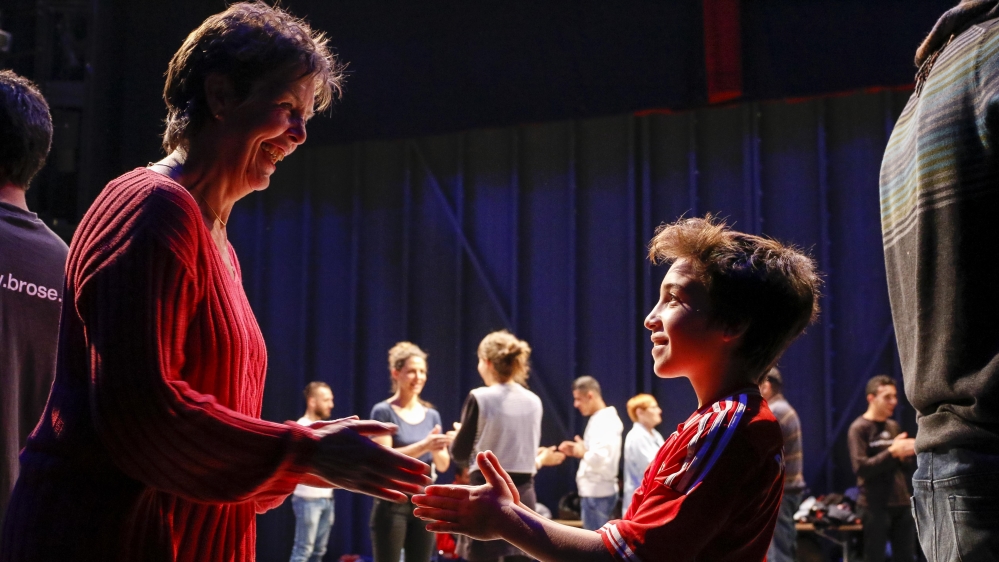
Refugee youth partake in the international cafe’s theatre activities and perform skits based on their own experiences [Daniel Koch/Staatsschauspiel Dresden]
Here, immigrants tell stories about their homelands and laugh with German volunteers about cultural differences. Graffiti covers the walls, a sign on one wall reads, “Refugees welcome. Bring your families.”
They do. Children play table football, while teenagers – mostly boys – lounge on couches.
But this particular space, known as the “international cafe”, rests in an uncanny location.
Dresden, the capital of Saxony, is a stronghold for Germany’s anti-immigrant politics. Each week, thousands of supporters of the right-wing, anti-Muslim, anti-refugee movement PEGIDA gather to demonstrate against Germany’s liberal policies towards asylum seekers.
They chant that refugees should “go home” and denounce what they see as the Islamisation of Germany. Refugees often take care to avoid central Dresden on Monday nights out of fear they’ll become targets of the protesters’ angry speech, or worse.
Read the full story at Al Jazeera. This is the final story in a 7-part series.

Photo by Journalistenwatch, flikr.
Last week I wrote about an attack on a refugee housing complex in Altenburg, Germany, in which two baby carriages were set aflame. It occurred just two days after members of a right-wing, anti-immigrant movement called PEGIDA marched through the town. That piece grappled with the question of how Germany—a nation with an unparalleled record of confronting its past—has found itself once again home to a small but active collection of xenophobes willing to resort to hate speech or even violence against newly arrived refugees.
But what is Germany doing to protect asylum seekers from right-wing terrorism? In 2015, the newspaper Die Zeit counted 220 violent attacks against refugees but only four convictions. Last year, the number of attacks (including ones that did not result in violence) exploded to 3,500.
How to stop this proliferation? Read the full piece at Columbia Global Reports.

Photo by Arnaud333, Wikimedia Commons.
On December 7, 2015, two baby carriages were set on fire at an apartment complex housing refugees in the pristine Thuringia town of Altenburg. Ten refugees, including two infants, suffered from smoke inhalation. The attack came two days after right-wing protesters marched through the town carrying signs that read, “Please continue your flight. There’s nowhere to live here.”
“On the ground floor there was a woman living with her baby who had to jump out without shoes,” district administrator Michaele Sojka told me when I met her last June. “Everyone was really shocked that something like that could happen in our city.
Two men were arrested, and six months later one of them was found guilty of arson. The judge said the man had “acted on xenophobic motives.” The other was handed a fine for repeating Nazi slogans. “One of them must have been drunk that night,” Brit Krostewitz, a volunteer with the Altenburg Network for Integration, told me. “They are just stupid Nazis.” Most Germans know the type.
This is Germany, a country whose leaders just 80 years ago tried to deport and then exterminate all non-Christians and “outsiders.” A country so ashamed of its xenophobic past that to display any hint of nationalism, such as to wave a German flag during a soccer match, remained taboo. Germany, a liberal European state that goes so far as to limit speech—by criminalizing Holocaust denial—least anyone attempt to forget or manipulate that torrid past.
And yet, Germany has recently become a breeding ground for small pockets of xenophobic citizens to commit hate crimes and terrorism against foreigners.
Read the full story at Columbia Global Reports. This is the first part of a short series on refugees in Germany.

Illustration by Jawahir Al-Naimi/Al Jazeera
In Freital, Abu Hamid and his fellow refugees were attacked by right-wing Germans, who could be convicted of terrorism.
Freital, Germany – On Halloween night, 2015, in this town outside the Saxon capital of Dresden, Abu Hamid went into the kitchen to grab some food when he noticed sparks of light outside the window. Sensing danger, he and his roommates rushed out of the kitchen just as a booming explosion shook the house, shattering the windows and sending pieces of glass into one man’s face.
“After that, we thought someone would come inside the home and attack us,” Abu Hamid said. “One of my friends, he took a knife.”
The explosion was caused by illegal fireworks, as they later discovered. It appeared someone had placed them on the windowsill that night to target those inside. For months beforehand, local police had failed to see a connection between a series of right-wing protests against refugee housing shelters and the bombing of a car belonging to a left-wing politician in Freital. Just one month before Abu Hamid’s apartment was attacked, another, almost identical firework attack had been launched on the house of some Eritrean refugees in the town.
It wasn’t until news outlets as far away as Berlin began pressuring authorities to take action that Germany’s federal prosecutor took up the case. In a dramatic SWAT-style raid, federal and state police arrested five suspects believed to have formed an organised anti-refugee militia.
Read the full story at Al Jazeera. This is the fifth story in a seven-part series.

A police car is parked in front of an asylum shelter in Clausnitz in March 2016 [Hannibal Hanschke/Reuters]
Once the face of anti-refugee sentiment in Germany, Clausnitz and its newcomers have learned to co-exist.
On a cold night last year, some 70 Germans, mostly men, surrounded a bus of refugees in this small town and began chanting at them to “go home”.
It was February 2016, and nearly one million asylum seekers had arrived the previous year to Germany from the Middle East, Africa and elsewhere. As they waited to see if they’d be allowed to stay, they were sent off to live in different cities and towns across the country.
One bus with 15 asylum seekers from Syria, Lebanon, Iran and Afghanistan was sent one evening to the village of Clausnitz, in the eastern German state of Saxony.

Their hostile reception by protesters who shouted at them and blocked them from entering their apartments made international headlines. A video of the encounter circulated widely, reinforcing stereotypes of small-town Germans as racist and blemishing Germany’s so-called “welcome culture”.
The refugees pleaded to the driver to turn around and return them to the temporary shelters they’d been living in around Dresden, the Saxon capital. Neither the refugees nor the demonstrators wanted this. But then, neither had a choice.
Read the full story at Al Jazeera. This is the 4th story in a 7-part series.
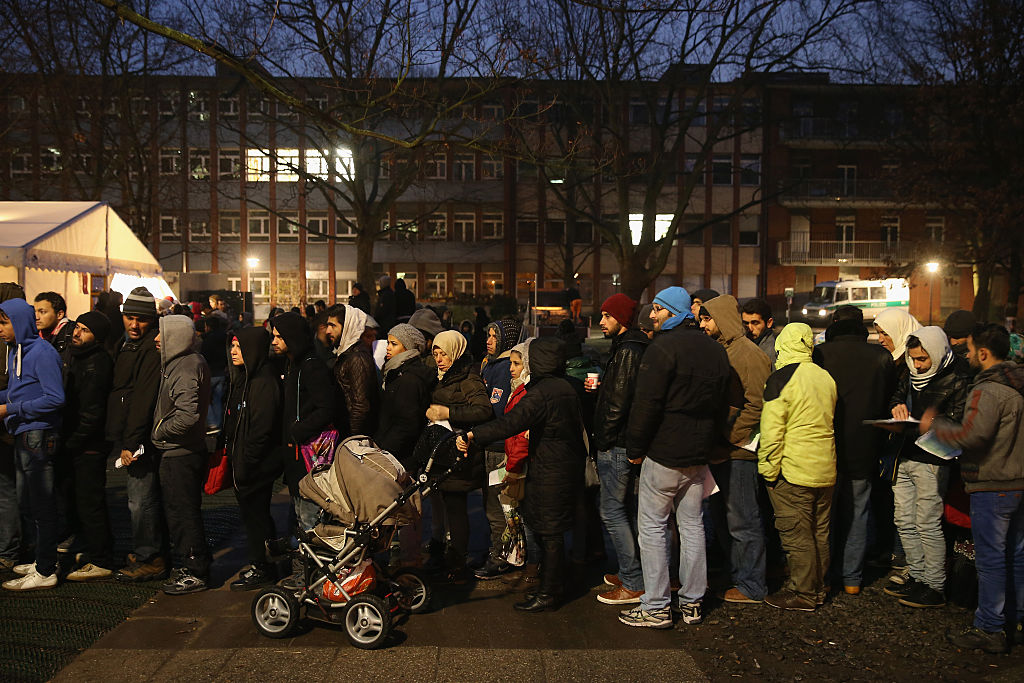
Refugees wait outside the State Office of Health and Social Affairs in the early hours of December 9, 2015 [Sean Gallup/Getty Images]
At the start of the refugee crisis, dysfunction and danger awaited those registering for asylum in Germany.
Before the wheels of Germany’s asylum system were fully turning, hundreds of thousands of newly arrived refugees were piling up in cities throughout the country. In Berlin, tens of thousands were forced to sleep on the streets at night and fight for their place in line by day at the now-infamous Lageso , the State Office of Health and Social Affairs, while they waited to apply for asylum.
 The climate of fear and tension at Lageso reached its climax one afternoon in October 2015 when a 32-year-old German man appeared at Lageso and, in the chaos of the crowds, enticed a four-year-old Bosnian boy named Mohamed away from his family and abducted him.
The climate of fear and tension at Lageso reached its climax one afternoon in October 2015 when a 32-year-old German man appeared at Lageso and, in the chaos of the crowds, enticed a four-year-old Bosnian boy named Mohamed away from his family and abducted him.
Read the full story at Al Jazeera. This is the 3rd story in a 7-part series.
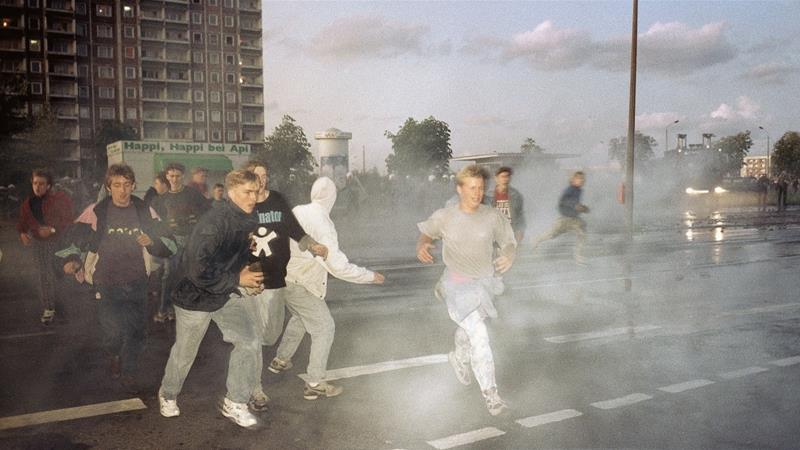
Right-wing extremists run through spray from water cannons during clashes between police and demonstrators in Rostock, Germany, on Monday, August 24, 1992 [Thomas Haentzschel/AP]
In the quarter of a century since, many foreigners arriving in Germany have experienced the warmest of welcomes – but a few have experienced chilling acts of hatred. This series explores how a small minority of ultra-xenophobic Germans has tarnished their nation’s reputation as a haven for the world’s displaced masses. These stories are primarily told through the experiences of immigrants and asylum seekers who survived xenophobic harassment or attacks.
 Their stories are the exception to the norm: incidents of violent xenophobia are rare in Germany compared with other countries. Indeed, Germany has welcomed more asylum seekers in recent years than any other European nation – the United Kingdom, France, Poland, Austria, Hungary, and magnitudes more than the far more populous United States. When faced with the largest exodus of people since World War II, none of these nations welcomed refugees as unconditionally as Germany did. It’s precisely because of this reputation that Al Jazeera is taking a hard look at what happens on the occasions when that welcome culture goes awry.
Their stories are the exception to the norm: incidents of violent xenophobia are rare in Germany compared with other countries. Indeed, Germany has welcomed more asylum seekers in recent years than any other European nation – the United Kingdom, France, Poland, Austria, Hungary, and magnitudes more than the far more populous United States. When faced with the largest exodus of people since World War II, none of these nations welcomed refugees as unconditionally as Germany did. It’s precisely because of this reputation that Al Jazeera is taking a hard look at what happens on the occasions when that welcome culture goes awry.
This is the first story in a 7-part series. Read it at Al Jazeera.
Story 2: Ibraimo Alberto, a Mozambican immigrant and child of former slaves, encountered many opportunities in Germany. But he also experienced racism, big and small, in the east and west– including the murder of a friend. Read his story at Al Jazeera.
Story 3: The climate of fear and tension among more recent refugees arriving to Germany reached a climax one afternoon in October 2015 when a 32-year-old German man enticed a four-year-old Bosnian boy named Mohamed away from his family and abducted him. Read the story at Al Jazeera.
Story 4: On a cold night last year, some 70 Germans, mostly men, surrounded a bus of refugees in the small town of Clausnitz and chanted at them to “go home”. On the bus were 15 asylum seekers from Syria, Lebanon, Iran and Afghanistan. Their hostile reception by protesters who blocked their path made international headlines, reinforcing stereotypes of small-town Germans as racist and blemishing Germany’s so-called “welcome culture.” Neither the refugees nor the demonstrators wanted this. But then, neither had a choice. Read the story at Al Jazeera.
Story 5: On Halloween night, Abu Hamid went into the kitchen to grab some food when he noticed sparks of light outside the window. Sensing danger, he and his roommates rushed out of the kitchen just as a booming explosion shook the house, shattering the windows and sending pieces of glass into one man’s face. Local police had failed to see a connection between a series of right-wing protests against refugee housing shelters. It wasn’t until news outlets as far away as Berlin began pressuring authorities to take action that Germany’s federal prosecutor took up the case. In a dramatic SWAT-style raid, federal and state police arrested five suspects believed to have formed an organised anti-refugee militia. Read the story, Escaping Aleppo only to encounter terrorism in Germany, at Al Jazeera.
Story 6: A lawyer and his family fled death threats in Pakistan, so they flee to Germany for safety. Instead, their building is attacked–firebombed–by right-wing Germans. Khan wondered whether Germany would accept their asylum applications, and allow them to stay. “Tomorrow, I don’t know what will happen,” Khan said. “Maybe Germany will say, ‘Out!'” In fact, it did. Read the full story at Al Jazeera.
Story 7: Each week in Dresden, a group of refugees and Germans gather at a nondescript cafe hidden from view, pushed back from the street. The cafe provides a safe space for them to mingle with the locals to chat, practise their language skills, and sip tea and juice. It’s one of many spaces that have popped up across Germany to welcome refugees, help them with their asylum applications, teach them German, or just for engagement.
But this particular space, known as the “international cafe”, rests in an uncanny location. Dresden, the capital of Saxony, is a stronghold for Germany’s anti-immigrant politics. Each week, thousands of protestors chant that refugees should “go home” and denounce what they see as the Islamisation of Germany. Read the full story at Al Jazeera.
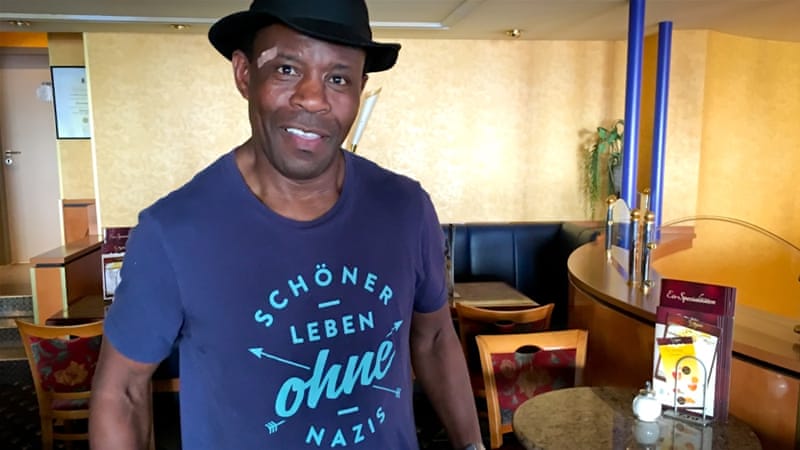
Ibraimo Alberto was born to former slaves in Mozambique when it was still a Portuguese colony. His parents worried he would be forced into slavery when he went to Germany [Jacob Kushner/Al Jazeera]
In the quarter of a century since, many foreigners arriving in Germany have experienced the warmest of welcomes – but a few have experienced chilling acts of hatred. This series explores how a small minority of ultra-xenophobic Germans has tarnished their nation’s reputation as a haven for the world’s displaced masses. These stories are primarily told through the experiences of immigrants and asylum seekers who survived xenophobic harassment or attacks.
Their stories are the exception to the norm: incidents of violent xenophobia are rare in Germany compared with other countries. Indeed, Germany has welcomed more asylum seekers in recent years than any other European nation – the United Kingdom, France, Poland, Austria, Hungary, and magnitudes more than the far more populous
United States. When faced with the largest exodus of people since World War II, none of these nations welcomed refugees as unconditionally as Germany did. It’s precisely because of this reputation that Al Jazeera is taking a hard look at what happens on the occasions when that welcome culture goes awry.

A child of former slaves, Ibraimo Ibraimo Alberto, a Mozambican immigrant, encountered many opportunities, but also experienced racism, big and small, in the east and west– including the murder of a friend. Read his story at Al Jazeera. This is the 2nd story in a seven-part series.
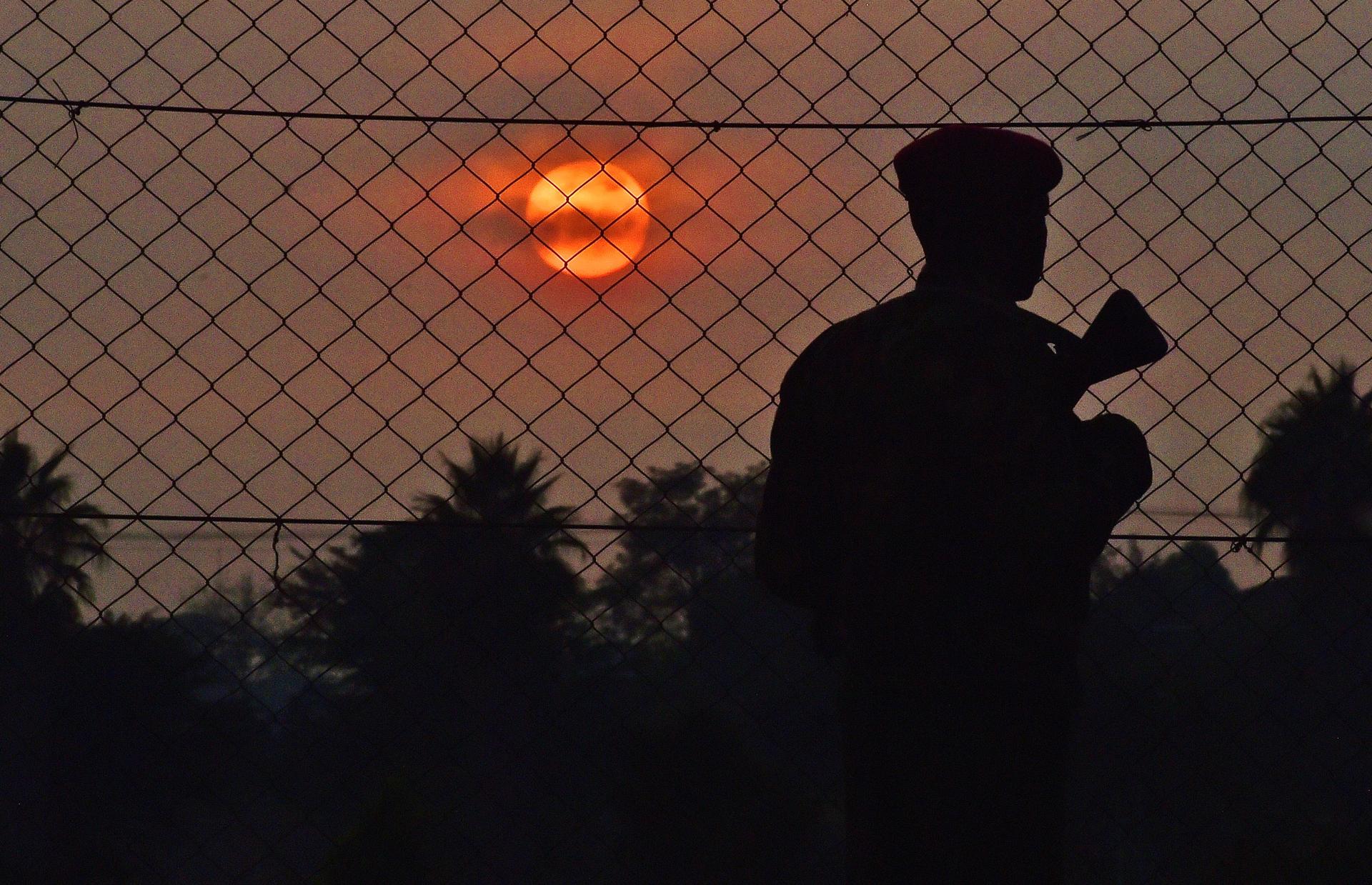 NAIROBI, Kenya — Kenyan police have fueled the fires of Islamic extremism and may actually be undermining the country’s security in an overzealous attempt to protect it, according to human rights activists and advocates for police reform.
NAIROBI, Kenya — Kenyan police have fueled the fires of Islamic extremism and may actually be undermining the country’s security in an overzealous attempt to protect it, according to human rights activists and advocates for police reform.
Widespread allegations of police corruption, brutality and arbitrary arrests that target Kenya’s Muslim minority population appeared to inform President Obama’s comments in a joint press conference with Kenyan President Uhuru Kenyatta on Saturday, part of Obama’s first trip to his father’s homeland since becoming president of the United States.
“What we have found through hard experience — I have shared this with President Kenyatta — is that if you paint any particular community with too broad a brush, if in reaction to terrorism you are restricting legitimate organizations, reducing the scope of peaceful organization, then there can have the inadvertent effect of actually increasing the pool of recruits for terrorism and resentment in communities that feel marginalized,” Obama said.
Read the full GroundTruth story at PRI’s The World.
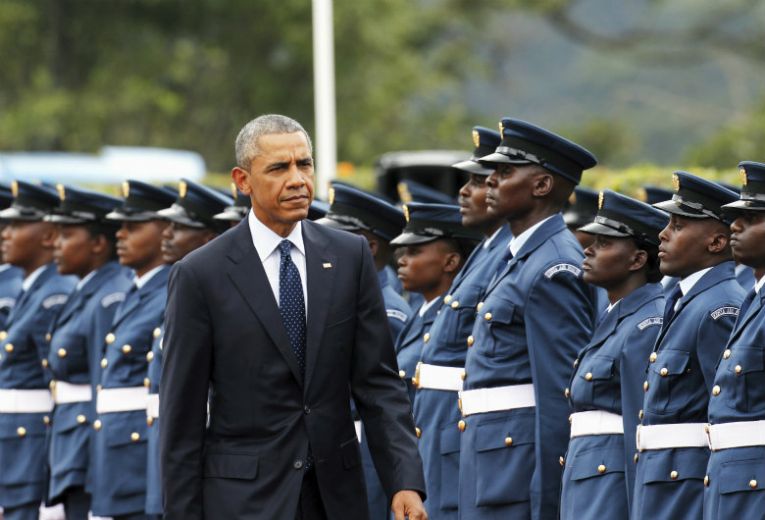
President Barack Obama reviews a Kenyan Defense Force honor guard in Nairobi. (Photo: Thomas Mukoya/Reuters)
NAIROBI–Barack Obama is visiting his father’s homeland for the first time as president, and he could hardly have chosen a more critical moment. Kenya was once a peaceful nation known for safaris and beaches. But it has, sadly, evolved into something resembling a police state—the result of the Kenyan government’s response to a recent onslaught of terrorist attacks.
As Kenyan security forces attempt to defend their nation, terrorism analysts and human rights activists say they’re going about it all wrong—inflicting collective punishment on Muslims and clamping down on press. Now, one very big question remains: Can President Obama convince Kenya’s leaders to take action on terrorism and human rights?
Read the full story at TakePart.

SIMON MAINA
Kenya’s counterterrorism approach following the Westgate Mall attack is crude — and may actually be spawning more violence.
NAIROBI, Kenya — At around 7:30 p.m. on March 31, three blasts went off in Nairobi’s Eastleigh neighborhood. The explosions, which police say were caused by grenades, killed six and injured around a dozen civilians congregating at two local cafes in the suburban area, which is dominated by ethnic Somalis.
mens nike shox nz
The bombings were only the latest in a spat of terror attacks following the September 2013 siege of Westgate Mall by Somali gunmen, which left 67 people dead. In December, a grenade blast killed four people in Eastleigh. In late March, unidentified gunmen entered a church near the coastal city of Mombasa, killing six. In all, nearly a dozen attacks that bear the marks of al-Shabab, a jihadist group based in Somalia that was responsible for the Westgate attack, have rattled Kenya since last fall.
Police are taking a high-profile approach as they respond to these attacks, detaining thousands of Somalis and Kenyan citizens of Somali heritage. But stops and arrests are not based on intelligence. Rather, police officers simply scour ethnic-Somali neighborhoods, sweeping up civilians from the streets.
Terrorism analysts say this sort of policing may actually be making Kenya less safe. As indiscriminate profiling becomes the fabric of security procedures, hundreds of thousands of Kenyan-Somali Muslims — a group from which al-Shabab affiliates are actively attempting torecruit — have something to be angry about. The government’s ethnic-focused, and often brutal, anti-terror tactics thus may be fueling the very attacks they are meant to suppress.
Read: Foreign Policy Magazine
 NAIROBI, Kenya —Today marks six months since gunmen trained by the Somali-based terrorist group al-Shabaab stormed a popular shopping mall here, in a siege that left 62 civilians and five Kenyan soldiers dead, and at least 200 others injured.
NAIROBI, Kenya —Today marks six months since gunmen trained by the Somali-based terrorist group al-Shabaab stormed a popular shopping mall here, in a siege that left 62 civilians and five Kenyan soldiers dead, and at least 200 others injured.
louis vuitton handbags online
The victims consisted of both Kenyans and expatriates. Their families and friends remained traumatized by the attack and angered by the government’s response, during which Kenyan soldiers looted the mall, even while bodies remained strewn about.
The Israeli-owned Westgate Mall opened in 2007. It was a popular hangout for Kenyans and expatriates alike until it collapsed during the September 2013 siege. But one group of Kenyans in particular holds a uniquely intimate connection to the mall and the event that destroyed it: These hundreds of Kenyans were employed in the mall’s 80 shops and restaurants, and depended on the mall for their livelihoods.
nike outlet stores
Their wages, small by western standards, supported their families or paid for their continuing education.
When the gunshots erupted, workers fled side-by-side with patrons. Some hid from the gunmen for upwards of 11 hours before being rescued. In small acts of heroism, some workers led others up or down staircases to safety, or out back doors.
In the aftermath of the attack, some were transferred to other franchise locations owned by their employers. But many lost their jobs entirely.
Six months later, GlobalPost asked mall employees to reflect on how the attack changed their lives and how they are coping with its long-lasting effects.
Read the full story and watch the video at GlobalPost.